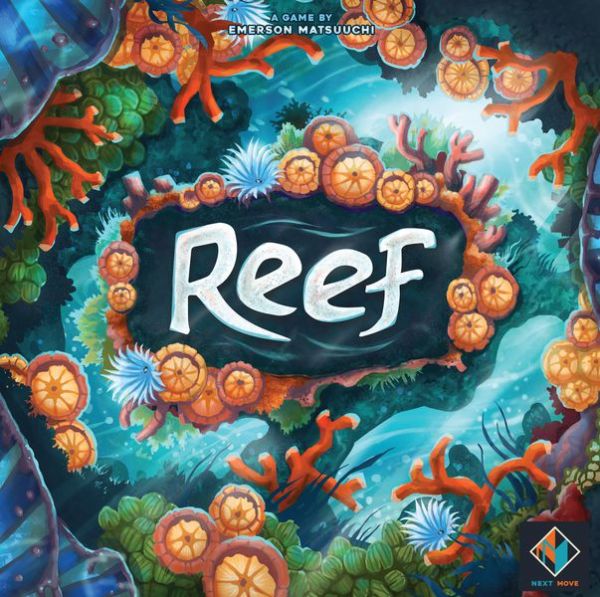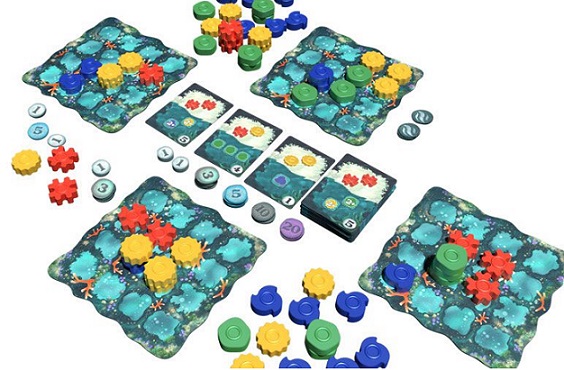Exploring Reef: An Abstract Game of Corals, Patterns, and Stacking

Reef is a puzzle that will ask you to plan ahead and consider each choice you make and how you stack your pieces.
From beautiful box art to lovely components, the game lacks nothing in presentation. But how does it play?
Gameplay
Each player is given a player board. The player board shows a four-by-four grid of spaces. You start the game with one coral piece of each of the four colors, placing them on the four center spaces on your board. Each player is also dealt two cards. Three cards are then placed face-up in the center of the table and the deck of cards is placed face-up next to them.
On your turn you can either play a card or take a card from the table or deck and add it to your hand. If you take a card from the deck, however, you must place one of your one point tokens onto one of the three cards on the table.
When you play a card, you take the coral pieces shown on the top half of the card from the supply and place them anywhere on your player board (coral pieces can be stacked on top of each other up to four pieces per stack). Once placed, a coral piece may not be moved.
You then check the pattern of coral pieces on the bottom half of the card. For each time that pattern appears on your board, you score the number of points shown on the card. When checking for a pattern, you only check the pieces on the tops of your stacks. Some patterns may be a certain color of coral, three in a row for example, while others require a specific color of coral to be on a stack of a particular height. Other patterns will score points for each coral of a particular color that is adjacent to your tallest stack of another particular color.
Once the supply of at least one color of coral runs out, the game ends. Players are able to score the patterns on the cards still in hand (but may only score the patterns once each). Then the player with the highest score wins the game.

Review
Reef is an abstract game with quick turns, minimal downtime, and very simple rules. While you have room to strategize and plan as you lay your corals, the rules governing the corals you collect, how you add them to the board, and even how you score patterns, are all straightforward.
The presentation of the game is top-notch. It’s bright and colorful, has a lovely ocean theme, and the coral pieces are fun to play with. Creating the stacks is fun and the artwork is excellent.
There is, however, little to no player interaction in the game, outside of taking cards your opponents might want, but that’s likely to be incidental at best, particularly in four player games. The patterns you score will rarely be affected by the coral pieces you gathered that turn, so you need to plan multiple turns ahead. You also need to be careful when selecting cards — because of this, you may not have much opportunity to block others on purpose, as you focus on what you need.
Reef is a fun, fast game, with some really intriguing choices. You need to consider both the patterns and the corals on each card you select, and when you choose to play them can make quite the difference as well. If you enjoy abstract games, particularly ones with a puzzle element to them, give Reef a shot.
Pros: Great presentation, fast turns, easy to teach, the card abilities lead to some tough choices
Cons: Little to no player interaction







